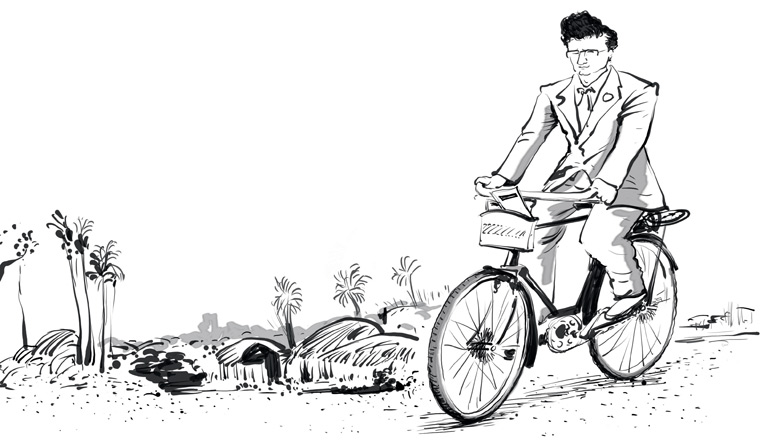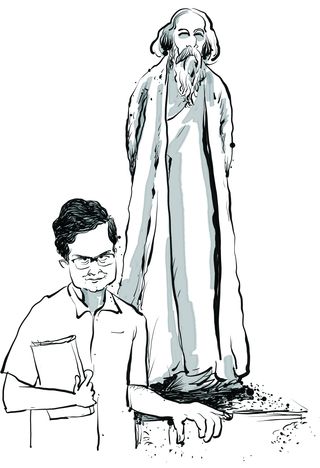I n Home in the World, Amartya Sen, a dear friend and contemporary, has achieved the impossible. We are with him in Shantiniketan, savouring its unique ambience. Tagore is there, and encourages our brave Amartya to improve his competence in Sanskrit. At another time he is cycling from Shantiniketan to old farm sheds and warehouses in neighbouring villages, transporting a weighing machine to weigh boys and girls up to the age of five, to collect data related to the Bengal famine of 1943. We then follow Amartya at the age of 19, sailing to the UK, filled with wonderment at the endless ocean he sees around him. Then the great leap forward as he explores, debates and redefines the various elements that make up economics—ethics, politics, statistics. From Aristotle to Wittgenstein to Gautama Buddha. He is forever curious, interested, amazed and intrigued by the phenomena that he observes or reads about. Moving from ancient texts to contemporary ones and engaging with some of what captivates him. He then pursues an explanation and an exposition of these for the rest of his life.
Injustice between men and women in all the dimensions of life, especially amongst the less privileged, bothers him. Addressing the woman issue—or the gender issue, as it is called now—has been a recurring theme in Amartya’s work over the decades. While he does not spend much time on this issue in Home in the World, he provided many concepts and ideas which many of us took forward in our work. We tried to redress the inequality between men and women—a pervasive phenomenon worldwide. In one of the first essays he wrote on women—Indian Women: Wellbeing and Survival—in The Economic Journal, to my great joy, he added a footnote acknowledging Pranab Bardhan and me for pointing out this issue.
While he has exposed, many times and in many places, this hidden inequality within gender, he has also given some wonderful messages and propositions in this area which I, for one, have used again and again. I quote, “Women should be seen not as patients whose interests have to be looked after, but as agents who can do effective things, both individually and jointly. We also have to go beyond their roles, specifically as consumers or as people with needs, and consider more broadly, their general role as agents of change who can, given the opportunity, think, assess, evaluate, resolve, inspire, agitate, and through these means, reshape the world.”
He dramatised the phenomenon of the killing of female babies, otherwise known as sex selective abortion and post birth killing. Another great social scientist, the late Dr Ashok Mitra, who was at one time Registrar General of the Census of India, brought to our attention the innovative ways in which couples killed the girl baby. For example, a technique which he said was very common in Gujarat was called ‘Doodh Peeti’. He said female newborns were drowned in a pot of milk, with the killers proposing that the child died while drinking it—abominable. So these challenges and cruelties that Indian women experienced were a great preoccupation with Amartya in his quest for enabling, through knowledge, the building of a humane and just society.
I cannot but help relate an anecdote which I witnessed. In Home in the World, Amartya has written about his arrival, for the first time, at the Delhi School of Economics, and his happiness and surprise to see how bright the students were. He has also written that he started to work on welfare economics. The news that we had a brilliant economist from Cambridge who was also interested in welfare, society and injustice spread. Thus, Durgabai Deshmukh, who was leading the cause for more funding for social welfare, and finding that her husband, then finance minister, C.D. Deshmukh, was not obliging, accosted me one day and expressed a desire to meet Amartya. So I arranged the meeting. Many years later, Amartya told me how much he had enjoyed meeting her, apart from the idlis she fed him. Amartya wrote a pamphlet for her justifying the expenditure. It is such moments and conversations that led to the acceptance of human development as an economic issue. In his book, Amartya has spent some time describing his friendship with Mahbub ul Haq, the economist from Pakistan with whom he formulated the human development report, an annual publication of the United Nations. Justice is a virtue that Amartya embraces, and in his excellent book, The Idea of Justice, he explores this element across disciplines and peoples.
So the integration or homogenising of various disciplines and breaking their rigid boundaries is one of the great contributions of Amartya. His detailed description of the scholars he met and engaged with in Cambridge guides us to the birth of his ideas. Indeed, Amartya has flooded the social sciences with ideas and vocabularies, leading to their linking. Philosophy, history, sociology and mathematics are threads into which economics is woven. In his description of his conversations with a range of scholars, especially at Cambridge—like Maurice Dobb, James Mirrlees, Dennis Robertson and Piero Sraffa—we see a beautiful mind that can draw the threads of various sources of knowledge into a weave.
Shabash, Amartya. Many of us, your old friends, know much about your life’s journey. What you have brought into this volume is the intellectual discourse, the triggers that moved you to concepts, theories, thoughts, essays, lectures and books.... Well done, dear friend.
—Devaki Jain is an economist and Hon Fellow, St Annes College, Oxford.
Home in the World: A Memoir
By Amartya Sen
Published by Allen Lane
Price Rs899; pages 480





